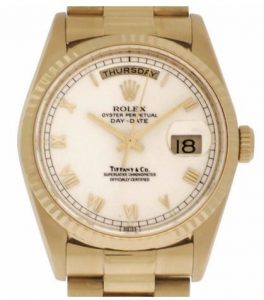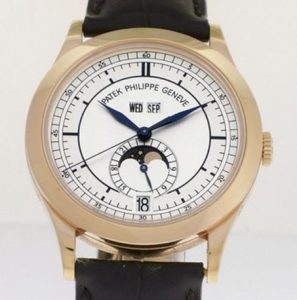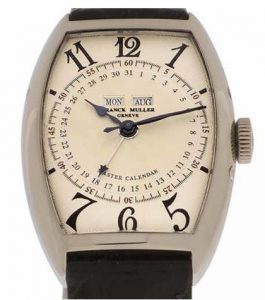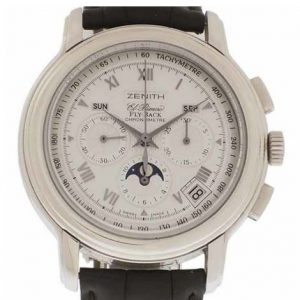Calendar Watches: Rolex and beyond
With our calendar year coming to a close soon and a new year starting, it’s a great time to take a look at some highly functional, and much-coveted timepieces: calendar watches.
These brilliant complications can track the day, date, month, year, leap year, moonphase and more. They range from the simple day-date watch to a full or complete calendar, the annual calendar watch and, at the top of the line, the perpetual calendar watch.
Day-dates that live in history
A day-date watch is a simple complexity added to a regular timepiece (two-hands or three-hands) that indicates the day of the week and the date. The term “simple complexity” refers to a watch that offers more than time-only indication but that is not considered highly “complicated.” (Learn more about complications here.) The best known day-date watches come from Rolex, the most coveted being the Rolex Day-Date.
The Day-Date is also known as the “President’s Watch” because so many world leaders have chosen to wear it, including Lyndon Johnson, a well-known watch connoisseur. The day-date is further distinguished by the three-link President bracelet. (Learn more about Rolex bracelets here.) Launched in 1956, it features an arc aperture at 12 o’clock with the day written out and a circular date aperture at 3 o’clock with magnifying window. The day instantly changes at midnight. This presentation has become an icon for the brand and Rolex makes them in 26 languages. If you’re multilingual, you might like a foreign language version. Somehow it’s cooler to see “Lundi” instead of “Monday,” isn’t it?


The movement behind the days and dates
Typically, the movement of a day-date watch is accomplished with two rotating disks, one that offers the date indication and one that offers the day of the week indication with the days spelled out. The latest Rolex Day-Date 40s have a new movement, caliber 3255. It has a power reserve of approximately 70 hours, and is extra resistant to changes in temperature and magnetic fields thanks to the Parachrom hairspring. Reassuring if you’re a world leader on your way to or from Davos. In the making of these watches, the challenge is more about readability. Customarily, these watches are not skeletonized and the dial is simple and clean with just two apertures.
Keep in mind that your day-date watch needs adjusting at the end of every month, as the 31-day disk cannot “Skip” the “31” in months that have fewer than 31 days.
Annual calendar complications
While the day-date calendar displays just the day and the date, the annual or complete calendar also indicates the month on the dial, usually via an additional aperture. A moon-phase indication is an added and very popular feature, as well. They are usually accomplished with an aperture placed typically at 6 o’clock, as in this Patek Philippe, below. Depending on the mechanism the watch brand uses to display the day, date or month, complete calendars will include additional disks (day, date, month, moonphase) and sometimes extra pointer hands for watches that display the date on an outer dial perimeter. No wonder they are considered marvels of complication.


Franck Muller’s Master Calendar is a beautiful example of the designer’s grasp of envisioning information. The dates of the month nestle inside the second hand markers, delivering detail without clutter.


Calendars and other complications
The impressive feat of the annual calendar watch is that it tracks information correctly for an entire year – whether the month has 30 or 31 days – until the end of February. On March 1, the wearer needs to adjust the date to accommodate the short month, as the disks track only the months that have 30 and 31 days. The Zenith El Primero Chronomaster, below, is a perfect example of Zenith’s supremacy at movements. It combines a flyback chronometer, tachymeter, day-date, and moon.


The perpetual calendar vs. the annual calendar
The perpetual calendar displays the day, date, month, and moonphase based on the Gregorian calendar, and then tops it by indicating the year or leap-year. The great convenience of a perpetual calendar watch is that you don’t have to adjust the months throughout the year, as it can account for months of all lengths, including February’s short 28- and 29-day months.
The movement for a perpetual calendar watch is a complex system of gears, levers and disks designed to track time and date accurately until the year 2100. At that time, your grandson will need to take it in for an adjustment because the scheduled 2100 leap year will be skipped in order to keep our Gregorian calendar in sync with solar time.
Today’s watch brands continue to pursue perpetual perfection, with some offering moon phase indications that are accurate for more than 122 years before they show a slight deviation. Others combine calendar functions with chronographs, dual timers and hemisphere indications. Someday they may even make one that remembers your anniversary!



